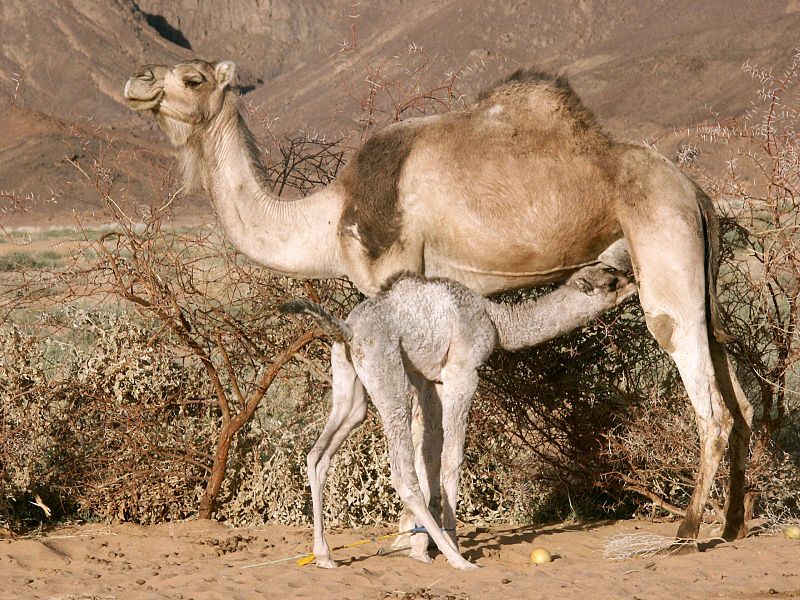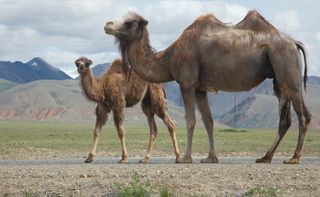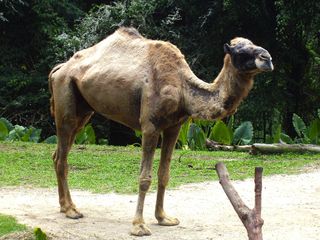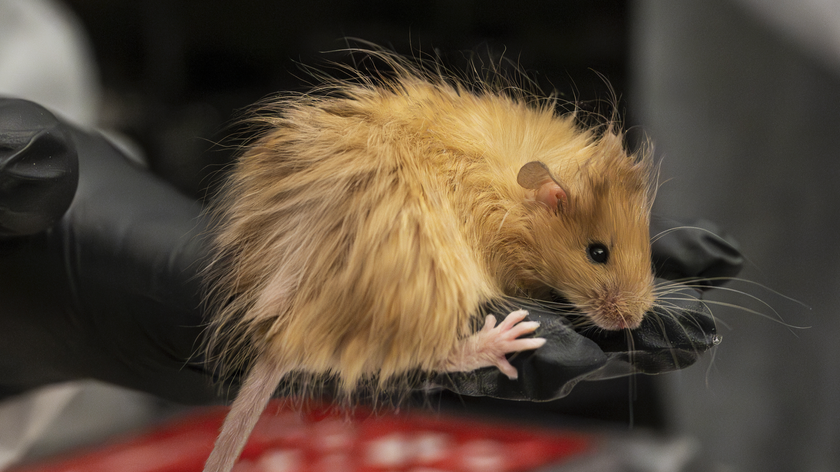Camels: Facts, Types & Pictures

Camels are mammals with long legs, a big-lipped snout and a humped back. There are two types of camels: dromedary camels, which have one hump, and Bactrian camels, which have two humps. Camels' humps consist of stored fat, which they can metabolize when food and water is scarce.
In addition to their humps, camels have other ways to adapt to their environment. They have a third, clear eyelid that protects their eyes from blowing sand. Two rows of long lashes also protect their eyes. Sand up the nose can be a problem, but not for camels. They can shut their nostrils during sand storms.
Humans have used camels as a means of transport for thousands of years. They can carry about 375 to 600 lbs. (170 to 270 kilograms) on their backs, according to National Geographic. This earned these beasts of burden a nickname, "ships of the desert." Domestic camels are often the main source of meat, milk and even leather or wool products.
Size
Most camels tower above humans. A Bactrian camel, according to the San Diego Zoo, grows to a shoulder height of 6 feet (1.8 meters) and a body length of 10 feet (3 m). They normally weigh 1,320 to 2,200 lbs. (600 to 1,000 kg) when they are fully grown.
Dromedary camels get up to about 6.5 feet (2 m) tall at the shoulder and weigh 880 to 1,325 lbs. (400 to 600 kg).

Diet
Camels aren't picky about what they eat. Their thick lips allow them to eat things that most other animals couldn't, such as thorny plants. Camels are herbivores, though, so you won't find them eating meat.
Filling up on water, when it's available, is very important for camels. They can drink 30 gallons (113 liters) of water in just 13 minutes. Their bodies rehydrate faster than any other mammal.
When there is little food and water, the camel's hump fat releases water; 9.3 grams of fat releases 1.13 grams of water, according to research by the University of Singapore.
Habitat
The two types of camel are found in different parts of the world. The dromedary camel, also called an Arabian camel, can be found in North Africa and the Middle East. The Bactrian camel lives in Central Asia. No matter the type, camels are usually found in the desert, prairie or steppe. Though many people think that camels only live in hot climates, they do well in temperature ranges from 20 degrees F (minus 29 degrees C) to 120 degrees F (49 degrees C).
Habits
Camels like to stay together in groups called herds. The herds are led by a dominant male, while many of the other males form their own herd called a bachelor herd. Camels are very social and like to greet each other by blowing in each other's faces.
Offspring
After a gestation of 12 to 14 months, a mother camel will find a private spot to have her young. Female camels usually only have one baby, but sometimes camels have twins.
Baby camels are called calves. The newborn calf is able to walk within 30 minutes, though the two won't rejoin the herd until around two weeks later. Camels become fully mature when they are 7 years old. Camels live around 17 years.
Classification/ Taxonomy
Dromedary camels (Camelus dromedarius) and the domestic Bactrian camel (Camelus bactrianus) were named in 1758 by Swedish zoologist Carl Linnaeus, who only knew of the domestic variety. Wild Bactrian camels (Camelus ferus) were discovered in 1878 by Nikolai Prejevalsky, a Russian geographer who explored Mongolia and Tibet.
For many years, the wild Bactrian was thought to be a subspecies of the domestic Bactrian. However, in recent years, DNA analysis confirmed that C. ferus was a separate species, according to the San Diego Zoo. The main difference between the two species is that the wild Bactrian has three more chromosome pairs than the domestic Bactrian.
Here is the classification of camels, according to Integrated Taxonomic Information System:
Kingdom: Animalia Subkingdom: Bilateria Infrakingdom: Deuterostomia Phylum: Chordata Subphylum: Vertebrata Infraphylum: Gnathostomata Superclass: Tetrapoda Class: Mammalia Subclass: Theria Infraclass: Eutheria Order: Artiodactyla Family: Camelidae Genus: Camelus Species:
- Camelus bactrianus (Bactrian camel)
- Camelus dromedarius (one-humped camel)
Subspecies:
- Camelus bactrianus bactrianus
- Camelus bactrianus ferus (wild Bactrian camel)
Conservation status

The wild Bactrian camel is considered critically endangered by the International Union for Conservation of Nature and has a population that is decreasing. In fact, wild camels are one of the most endangered large mammals. According to the Wild Camel Protection Foundation, there are fewer than 1,000 wild camels alive.
Other facts
Camels can run at 25 mph (40 kph) for long periods. If their owner is in a hurry, they can kick their speed up to 40 mph (67 kph).
The camel's hump is like a storage container. When camels use their stored fat, their hump will diminish. When they eat and drink again the hump will refill with fat.
Camels have oval-shaped red blood cells that help continue blood flow during times when water is scarce.
Camels are known for spitting on people. In fact, the animals are throwing up the contents of their stomach along with spit. This is a defense tactic when the animals feel threatened.
The large beasts make a variety of moans, groans and deep, throaty bellows. One of the camel's noises was even used to voice the character Chewbacca in the Star Wars movies.
Additional Resources
Sign up for the Live Science daily newsletter now
Get the world’s most fascinating discoveries delivered straight to your inbox.













